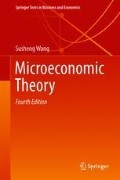Abstract
This chapter introduces the standard equilibrium theory of industry. We focus mainly on the output market and later cover briefly the input market.
Access this chapter
Tax calculation will be finalised at checkout
Purchases are for personal use only
Notes
- 1.
Even though a firm may decide to produce in the short run (when the firm is taking a short-term view), it may decide to leave an industry in the long run (when the firm is taking a long-term view).
- 2.
A demand function is typically written as \( y = f (p) \), meaning that the quantity demanded y is dependent on the price. We often write \( y^{d} = f (p) \) to indicate it as a demand function. When this function f is strictly decreasing, we can also express the demand relationship by \( p = f^{ - 1} (y) \) or \( p = g (y) , \) where \( g \) is the inverse function. We call this the inverse demand function. Again, we often write \( p^{d} = g (y) \) to indicate that it is a demand function.
- 3.
Rigorously, the revenue function is \( R (y) = \mathop \int \limits_{0}^{y} p (x) dx, \) implying \( MR (y) = p (y) \) for any \( y \ge 0 \).
- 4.
In our definition, we implicitly assume that there are no external costs and external benefits. In this case, the demand curve is the marginal social benefit (MSB) curve and the marginal cost curve is the marginal social cost (MSC) curve. The social optimal point is where the MSB and MSC curves intersect.
- 5.
The reactive equilibrium is defined by Riley (1979). Wilson (1977) defines the anticipated equilibrium, which is very similar to the reactive equilibrium.
- 6.
The fact that each player acts in his own best interest does not automatically mean that the game is noncooperative. For example, the players may work as a team for the total surplus of a project, but they may compete for or react to their shares of the surplus in their own best interests.
- 7.
We ignore the possibility that a consumer may not buy if the costs from both firms are too high. See Mas-Collel et al. (1995, p. 396) for a more general case in which this possibility is considered.
- 8.
There is no loss of generality with this assumption as we can always name the firm on the left to be firm 1.
- 9.
This is because, for \( x \in \left( {0, x_{1} } \right), \) if \( p_{2} + t\left( {x_{2} - x} \right) = p_{1} + t\left( {x_{1} - x} \right), \) then, for any \( \varepsilon \in {\mathbb{R}}, \) \( p_{2} + t\left( {x_{2} - x + \varepsilon } \right) = p_{1} + t\left( {x_{1} - x + \varepsilon } \right). \)
- 10.
In this case, we need to include a participation constraint: the consumer is willing to buy a unit from firm i only if \( p_{i} + td \ge v, \) where is the consumer’s utility value from consumption of the product. See Mas-Colell et al. (1995, p. 399).
- 11.
There are two standard models of spatial competition in the literature: the linear city model pioneered by Hotelling (1929), and the circular city model pioneered by Lerner and Singer (1939), developed by Vickrey (1964) and made popular by Salop (1979).
- 12.
If an integer is needed, the equilibrium number of firms is \( \hat{n} = \left[ {n^{ * } } \right]. \)
- 13.
Since a demand curve represents the maximum price (that the demander is willing to accept), a price ceiling is a ceiling on the demand curve. Since a supply curve represents the minimum price (that the supplier is willing to accept), a price floor is a floor on the supply curve.
- 14.
Since the rental rate is low, the landlords may have less incentive to maintain housing quality, which may reduce demand further (a leftward shift of the demand curves). If this reduction is large enough, it may cause an even lower equilibrium housing stock.
- 15.
We have drawn the MCP curve for a linear supply curve \( w (x) = a + bx \), which gives us some idea about the position of the MCP curve relative to the supply curve.
Author information
Authors and Affiliations
Corresponding author
Rights and permissions
Copyright information
© 2018 Springer Nature Singapore Pte Ltd.
About this chapter
Cite this chapter
Wang, S. (2018). Micro-foundation of Industry. In: Microeconomic Theory. Springer Texts in Business and Economics. Springer, Singapore. https://doi.org/10.1007/978-981-13-0041-7_6
Download citation
DOI: https://doi.org/10.1007/978-981-13-0041-7_6
Published:
Publisher Name: Springer, Singapore
Print ISBN: 978-981-13-0040-0
Online ISBN: 978-981-13-0041-7
eBook Packages: Economics and FinanceEconomics and Finance (R0)

